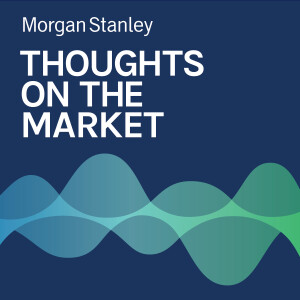
Andrew Sheets: The U.S. Dollar and Cross-Asset Portfolios
 2023-04-25
2023-04-25
With many investors predicting the U.S. dollar to continue to weaken, its potential for diversification and high yields may indicate otherwise.
----- Transcript -----
Welcome to Thoughts on the Market. I'm Andrew Sheets, Chief Cross-Assets Strategist for Morgan Stanley. Along with my colleagues bringing you a variety of perspectives, I'll be talking about trends across the global investment landscape and how we put those ideas together. It's Tuesday, April 25th at 2 p.m. in London.
The U.S. dollar has fallen about 11% from its highs last September. We think a majority of investors expect that weakness to continue, driven by factors ranging from expensive valuations to potential slowing of the U.S. economy, to the view that a more fragmented geopolitical backdrop will lead to less trade and transactions in U.S. dollars.
In contrast, our foreign exchange strategists think it's more likely that the dollar strengthens. I want to discuss the idea of dollar strength from a larger lens and what it could mean for a cross-asset portfolio.
For a multi-asset investor, the greatest appeal of the U.S. dollar comes from its diversification. At present, it is one of the few positive carry diversifiers, which is another way of saying that it's one of the few assets out there that pays you while also acting as a portfolio hedge, thanks to the dollar generally moving in the opposite direction of riskier assets like stocks or high yield bonds.
Importantly, that diversification from the U.S. dollar makes a lot of intuitive sense to us. We think the dollar could do well if U.S. growth is very hot, as investors are drawn to even higher U.S. rates under that scenario, or if growth is very weak as investors seek out safety and liquidity. These extremes in growth, we think, represent two of the key risks, for riskier assets.
In contrast, the dollar probably does weaken if growth is down the middle and a so-called soft landing for the economy. In this case, modest Fed easing without the fear of recession would likely cause investors to seek out cheaper, more volatile currencies. But this soft landing scenario is probably the best outcome for the riskier other parts of one's portfolio, allowing the dollar to provide diversification as it zigs while other assets zag.
But what about the dollar's higher valuation or the threat of geopolitical shifts? Well, on valuation, our work suggests that it tends to be a pretty weak predictor of foreign exchange returns over the next 6 to 12 months, for better or for worse. And on geopolitical shifts, the dollar remains the dominant currency of global trade. And importantly, over the last year, a year that’s contained quite a bit of geopolitical uncertainty, it's continued to show diversification benefits.
In summary, many investors expect U.S. dollar weakness to continue. Thanks to its high yield and powerful potential for diversification, we think it's more likely to appreciate.
Thanks for listening. Subscribe to Thoughts on the Market on Apple Podcasts, or wherever you listen, and leave us a review. We'd love to hear from you.
More Episodes
 2024-11-08
2024-11-08
 2024-11-07
2024-11-07
 2024-11-05
2024-11-05
 2024-11-01
2024-11-01
 2024-10-31
2024-10-31
 2024-10-30
2024-10-30
 2024-10-29
2024-10-29
 2024-10-28
2024-10-28
 2024-10-25
2024-10-25
 2024-10-23
2024-10-23
 2024-10-22
2024-10-22
 2024-10-15
2024-10-15
 2024-10-14
2024-10-14
Create your
podcast in
minutes
- Full-featured podcast site
- Unlimited storage and bandwidth
- Comprehensive podcast stats
- Distribute to Apple Podcasts, Spotify, and more
- Make money with your podcast
It is Free
- Privacy Policy
- Cookie Policy
- Terms of Use
- Consent Preferences
- Copyright © 2015-2024 Podbean.com




